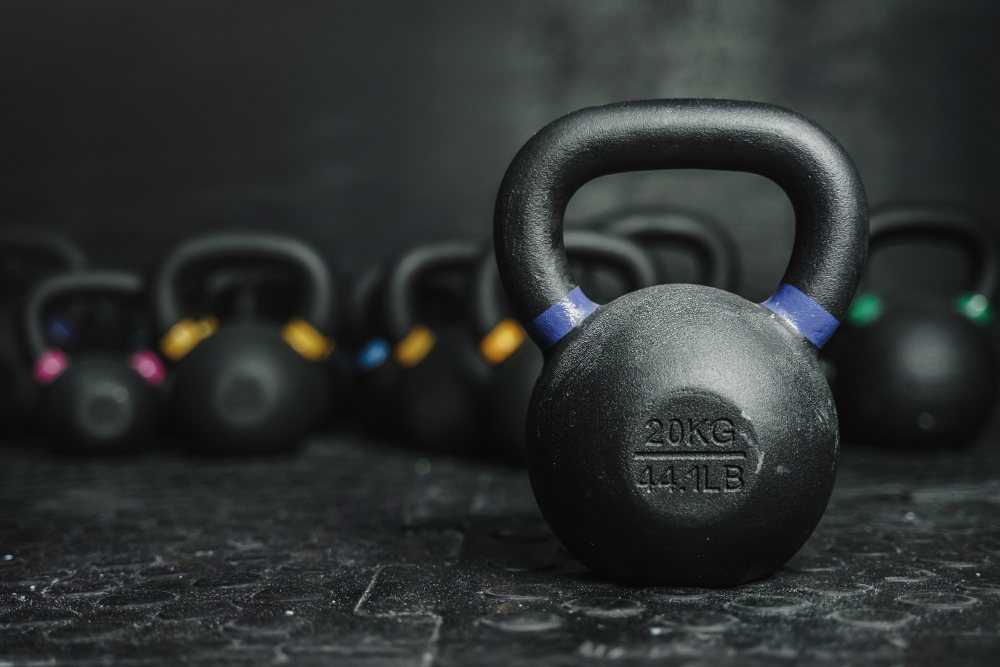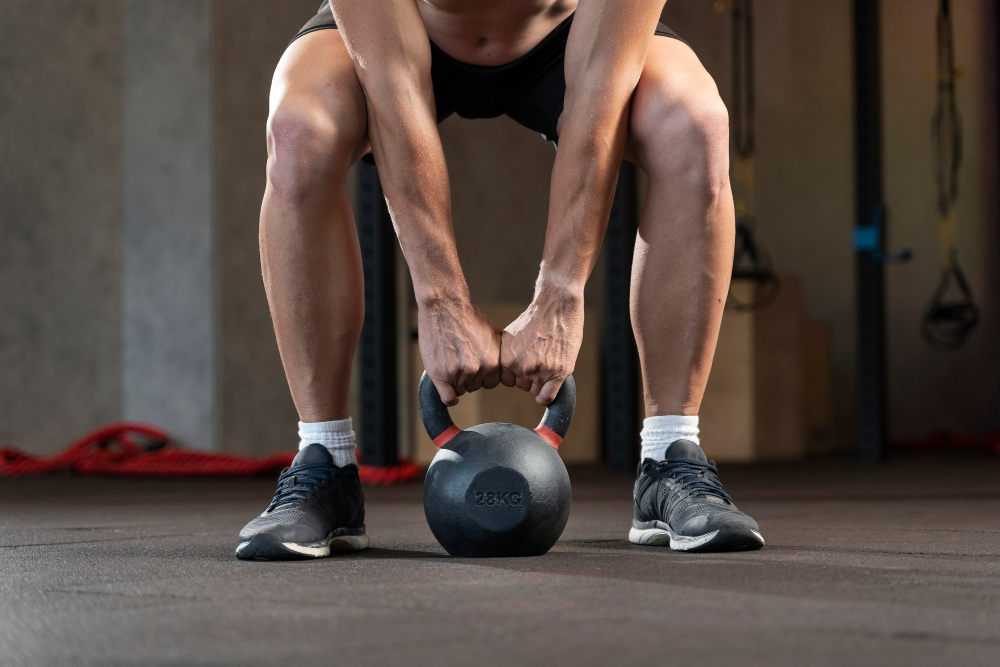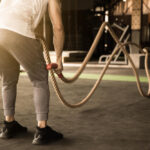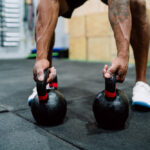BJJ Kettlebell Workout is all about efficiency. You’re hitting functional movements, firing up your grip and core, and building strength that actually shows up when you roll. Whether you’re clamping down on a collar or finishing a choke, this kind of training pays off fast. Since you have so many options when it comes to choosing the exercises, we’ve mapped out exactly how your BJJ kettlebell workout should look.
Best Kettlebell Exercises for BJJ
Kettlebell training for BJJ can be effective, but only if you choose the right exercises. When used correctly, they target everything that matters in BJJ, from grip and core to posterior chain and conditioning. So let’s look at the essential kettlebell exercises for BJJ:
1. Kettlebell Swings
Kettlebell swings are a go-to exercise for explosive hip power and conditioning. Swings target your glutes, hamstrings, and lower back, which means stronger bridges, faster hip escapes, and better takedown defense. They also hit your grip and build serious work capacity.
2. Turkish Get-Up
Turkish get-ups build shoulder stability, core control, and body awareness. It trains you to move under load in awkward positions, just like BJJ. You’ll notice better posture when you pass, more control in scrambles, and stronger frames under pressure.
3. Kettlebell Clean and Press
Kettlebell clean work your hips and traps, while the press challenges shoulder stability, triceps, and core. You’ll feel the benefit in any movement that needs explosiveness and upper-body endurance, like finishing a takedown or fighting grips.
4. Kettlebell Goblet Squat
Goblet squats train your quads, glutes, and core while reinforcing proper posture and balance. Great for guard passing, takedown base, and scrambling. Plus, holding the bell lights up your grip without even trying.
5. Kettlebell Rows
Rows are your pulling power. They build the lats, upper back, and grip—the muscle groups that control posture, break grips, and dominate clinch situations. Do them strictly and controlled, no jerking the weight around.
6. Kettlebell Snatch
Kettlebell snatch hits your shoulders, back, hips, and core, all while building serious cardio. Great for simulating the explosive bursts you feel in a tough roll.
7. Kettlebell Arm Bar (Mobility Drill)
The arm bar opens up your shoulders, strengthens stabilizers, and preps your body to resist injury. You can look at it as armor for your joints.
BJJ Kettlebell Workout Example
Here’s how to put together an effective kettlebell routine for BJJ.
The Format: Full-Body, High-Impact
Stick with full-body workouts 2 to 3 times a week. Each session should mix power, stability, and conditioning. That means:
- 1 power move
- 1 strength-based push or pull
- 1 core or stability drill
- 1 conditioning finisher
This keeps things balanced, functional, and mat-ready.
Sample Workout Structure
Warm-Up (5-10 minutes):
- Arm circles, bodyweight squats, kettlebell halos, light swings. Get everything firing.
- Power Exercise (3-4 sets, 6-8 reps per side)
- Kettlebell Clean and Press or Kettlebell Snatch
- Focus on explosive movement and clean form. This is your heavy hitter.
- Strength Movement (3-4 sets, 8-10 reps)
- Goblet Squat or Kettlebell Row
- Alternate between upper and lower body each workout to stay balanced.
- Core and Control (2-3 sets, 3-5 reps per side)
- Turkish Get-Up
- Go slow. This isn’t about speed. It’s about total-body tension and control.
- Conditioning Finisher (3 rounds, 30 seconds on / 30 seconds off)
- Kettlebell Swings or Kettlebell Snatches
- This mimics the intensity of a round. Push the pace, keep your form tight.
Optional Mobility / Cooldown (5 min):
- Kettlebell Arm Bars, hip openers, or light stretching to reset your body.
BJJ Kettlebell Circuit
If you prefer to keep your heart rate high and minimize rest, a circuit is the way to go. It’s fast, intense, and mimics the nonstop pace of rolling. You’ll build strength, endurance, and grip under fatigue, which is exactly what you need in live rounds.
How It Works
Pick 4 to 6 kettlebell exercises. Perform them back-to-back with little to no rest between. After the last exercise, rest for 1 to 2 minutes. That’s one round. Repeat for 3 to 5 rounds depending on your level.
Keep the weight moderate so you can move cleanly without losing form. Go with lighter weights. These types of workouts are all about building work capacity and staying sharp under pressure.
Sample BJJ Kettlebell Circuit
- Kettlebell Swings (15 reps)
Builds explosive hips and conditions your grip and posterior chain.
- Goblet Squats (10 reps)
Reinforces base, balance, and lower body strength.
- Clean and Press (6 reps per side)
Develops full-body power, shoulder endurance, and coordination.
- Kettlebell Rows (8 reps per side)
Targets lats and grip. Great for pulling and grip-breaking.
- Turkish Get-Up (1 rep per side)
Trains control, core stability, and shoulder resilience.
- Kettlebell Snatches (10 reps per side)
Finishes the round with a full-body conditioning hit.
Rest 60-90 seconds. Repeat 3-5 rounds.
You can swap exercises in and out based on your focus. Want more grip burn? Add bottom-up presses or farmer carries. Want more core? Add Russian twists or windmills. Just keep the flow tight and the intensity high.
Barbell vs Kettlebell for BJJ Workout
Barbells are great for raw strength. Squats, deadlifts, and presses are the lifts that load your body with serious weight. If you want to build max force for takedowns, sprawls, and heavy pressure, barbells work without a doubt.
Pros:
- Easy to progressively overload.
- Ideal for developing absolute strength.
- Builds a strong base for heavy grapplers.
Cons:
- Requires access to a gym or home setup.
- Less carryover to awkward, unstable positions.
- Not as joint-friendly if your technique’s off.
Kettlebells hit that sweet spot between strength and movement. You’re not just lifting, but instead you’re coordinating, stabilizing, and adjusting under load. This translates well to scrambles, transitions, and awkward grappling positions.
Pros:
- Builds grip, core, and shoulder stability.
- Great for conditioning and endurance under fatigue.
- Requires minimal space and equipment.
- Matches the flow and unpredictability of rolling.
Cons:
- Harder to build max strength.
- It takes time to develop good form.
- Weight jumps are less precise than barbells.
Best move? Use both.
Barbells for building your strength ceiling. Kettlebells for movement quality, grip, and mat-ready conditioning.
Final Thoughts
The BJJ kettlebell workout can be incredibly effective. With one tool, you can build explosive hips, iron grip, bulletproof shoulders, and cardio that holds up deep into the round. Whether you’re doing full-body sessions or high-paced circuits, kettlebells give you everything you need to move better, last longer, and hit harder on the mats.
FAQ
What weight should I use for a BJJ kettlebell workout?
Start with something you can control with good form, but still challenges you after a few reps. For most people, that’s around 26-35 lbs (12-16 kg) if you’re newer to training, or 44-53 lbs (20-24 kg) if you’ve got a solid strength base. You want a weight that’s heavy enough to build power but light enough to keep the flow and speed needed for BJJ-style conditioning.
What’s the best way to fit in kettlebell workouts with BJJ classes?
If you’re training BJJ 3-5 times a week, aim for 2 short kettlebell sessions on non-consecutive days. Do them on your lighter BJJ days or in the morning if you roll at night. Keep the workouts under 45 minutes. If you’re sore, scale it back. The goal is to enhance your rolling, not burn out.
Are kettlebells a better option than barbells if I want to work out from home?
Yes. Kettlebells are the best bang-for-your-buck training tool for home workouts. They take up almost no space, can hit every major movement pattern, and are perfect for building the kind of strength and cardio BJJ demands. Barbells are great for raw strength, but if space, noise, or cost are issues, kettlebells are a better choice.






